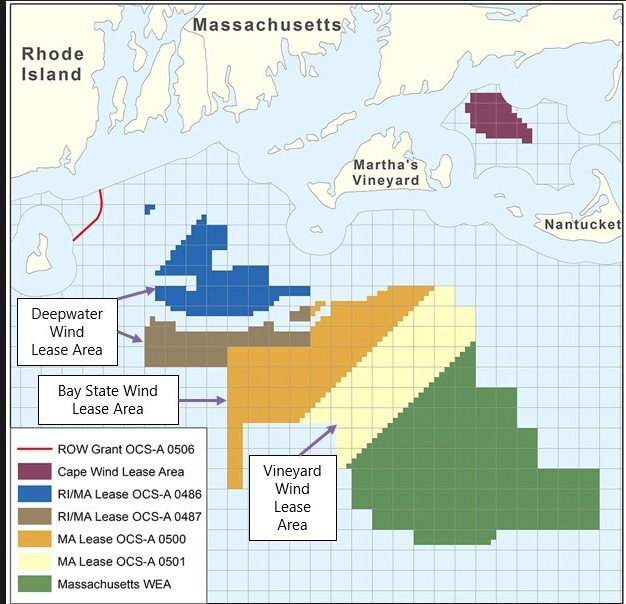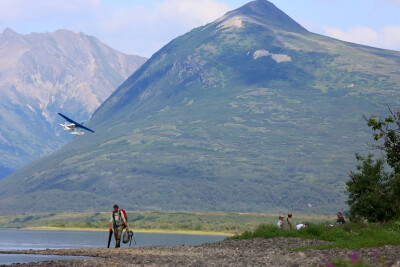The federal Bureau of Ocean Energy Management is extending its environmental review of the proposed 800-megawatt Vineyard Wind offshore wind project, and will expand its “cumulative impacts analysis” of other massive wind power plans for the East Coast.
The news Friday was another blow to Vineyard Wind’s plan for 84 turbines on its federal lease 15 miles south of Martha’s Vineyard, Mass. The company had expected BOEM approval of an environmental impact statement by mid-July, and had warned earlier that its $2.8 billion plan would be in jeopardy if the EIS was not forthcoming by the end of August.
Reaction in the U.S. offshore wind industry was cautious, with BOEM yet to detail exactly how it will go about the new effort and what the timetable will be. BOEM spokeswoman Tracey Moriarty told E&E News the review will extend to other projects that like Vineyard Wind have obtained power purchase agreements with states.
That would include three big plans for the New York Bight: Equinor's Empire Wind project near the approaches to New York Harbor, Ørsted's Sunrise Wind project off Long Island and its Ocean Wind project off Atlantic City, N.J.
BOEM's surprise move came as the New York State Energy Research and Development Authority announced a new round of studies to pave the way for developing the Equinor and Ørsted leases.
"We are monitoring the situation closely and at this time do not have any reason to believe that this decision will delay development of New York's recently awarded offshore wind projects," NYSERDA officials said in a brief statement Tuesday.
In an interview with Bloomberg Friday, Interior Secretary David Bernhardt said additional study has been ordered for the joint venture by Denmark-based Copenhagen Infrastructure Partners and Avingrid.
Many aspects of the plan, including the planned layout of turbines and accessibility and safe vessel transit, are under intense criticism from the New England fishing industry. NOAA has refused to sign off on the BOEM environmental review, saying those fishing industry concerns are not adequately addressed.
Fishing industry advocates said they have been working with federal regulators and Vineyard Wind, but have yet to resolve major issue including turbine array layout that would be compatible with fishing.
“The size, pace, and scope of proposed offshore wind energy projects on the Atlantic OCS (outer continental shelf) demand that lawmakers, regulators, developers, and the public all employ due caution to ensure that these developments can coexist with our traditional and historic fisheries,” the Responsible Offshore Development Alliance said in a statement late Tuesday.
Fishing businesses were providing their own proprietary data to BOEM and the developers “as early as 2017 in support of their requests for turbine spacing and orientation that would maximally accommodate fishing,” according to RODA. With more confidential fishing information and in meetings, fishermen sought to negotiate safe transit lanes through the wind leases, and in late 2018 BOEM and Coast Guard officials said those would be a requirement for wind power developments. Industry advocates contended there should be a few seasons of baseline fisheries surveys before construction on the leases.
“This input has not been delivered at the ‘eleventh hour’ and all occurred well within BOEM’s permitting timeline,” according to the RODA statement. “The mere citation of RODA’s concerns does not amount to the full evidence-based analysis that should be the basis of important federal decisions. The fishing industry remains resolute that the spacing and orientation of turbines within a project area is one of the primary factors in determining what fisheries impacts will be, and thus demands the utmost diligence in consideration and analysis.”
In a statement to Massachusetts news media groups, BOEM officials said they are also rethinking their cumulative analysis in light of accelerating development in the East Coast offshore wind energy market. The agency is looking at 13 planned developments from southern New England to the Carolinas, a region that wind promoters say is one of the world’s most attractive because of the wind resources and strong power demand from the U.S. East Coast metropolitan areas.
“Because BOEM has determined that a greater build out of offshore wind capacity is reasonably foreseeable than was analyzed in the initial draft EIS, BOEM has decided to supplement the draft EIS and solicit comments on its revised cumulative impacts analysis,” the agency said. Public comments during the process, including from other government agencies, called for “a more robust cumulative analysis,” according to BOEM.
The order to assess individual projects in the context of potential cumulative impacts "is extraordinary," said Liz Burdock, president of the industry group Business Network for Offshore Wind, in a prepared statement.
"This requirement adds cumbersome regulatory hurdles to an already long and arduous process — a process that the industry has thus far responded to with rigor, showing that this form of energy production is safe, protective of the environment, stimulating to the economy, and in keeping with the needs of all commercial interests," she said. BOEM should not "veer from the consistent, equitable and transparent process that the agency previously established," she said.
"It's really too early to know what this EIS process will bring," Burdock said Tuesday. "We haven't seen the scope of this environmental impact review."
For example, it's not clear yet how the expanded BOEM examination might dovetail with an ongoing Coast Guard study of potential vessel transit lanes and other considerations for the safe passage of vessels near turbine arrays. A draft plan for the East Coast should be forthcoming in the fourth quarter of 2019, Coast Guard First District officials have said.
For now the commercial fishing industry's concerns are at the top of the BOEM decision. Rhode Island's Congressional delegation has asked the agency to be more responsive to those issues; the Ocean State is a center for the East Coast squid fishery and operators say they cannot work with the way Vineyard Wind has designed its project.
Vineyard Wind was poised to begin breaking ground on shoreside construction in December, a deadline to qualify for a 12 percent federal investment tax credit for renewable energy — a long-running program to encourage alternative energy investments that is now expiring.
In a statement responding to news of the further BOEM review, Vineyard Wind officials insisted their project would keep moving, despite their “surprise and disappointment.”
“To be clear, the Vineyard Wind 1 project remains viable and continues to move forward. While we appreciate that the discussion on cumulative impacts is driven by rapid growth of the industry beyond our project, we urge the federal government to complete the review of Vineyard Wind 1 as quickly as possible,” the company said. “The project is poised to kickstart a new offshore wind industry that promises industrial growth along with new manufacturing and blue-collar employment across the United States from New England to Louisiana to Colorado and beyond.
“We firmly believe that once regulators are fully satisfied, our project and dozens of others will deliver billions of dollars of new investment in ports, enhanced energy independence, and above all, high-paying, long-term jobs for thousands of Americans.”
Massachusetts' political leaders are counting on that economic boost from offshore wind, and Gov. Charlie Baker and others have pressed Bernhardt to resolve the impasse between federal regulators.
The resulting delay is the latest twist in the Trump administration’s handling of offshore wind energy.
President Trump himself has an ambiguous relationship with the industry. Having lost a court challenge in the United Kingdom over an offshore wind development near his golf club in Scotland, Trump still occasionally ridicules wind power at his campaign rallies.







